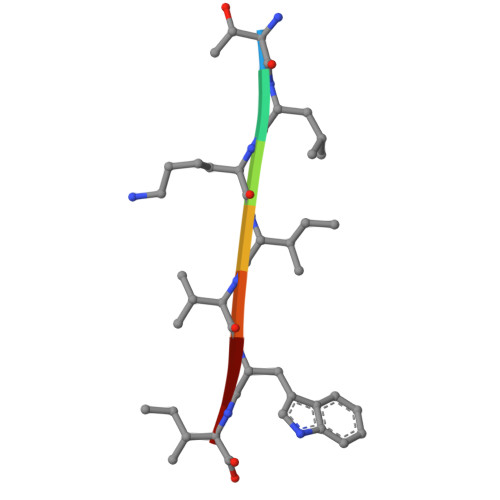How short peptides disassemble tau fibrils in Alzheimer's disease.
Hou, K., Ge, P., Sawaya, M.R., Lutter, L., Dolinsky, J.L., Yang, Y., Jiang, Y.X., Boyer, D.R., Cheng, X., Pi, J., Zhang, J., Lu, J., Abskharon, R., Yang, S., Yu, Z., Feigon, J., Eisenberg, D.S.(2025) Nature 644: 1020-1027
- PubMed: 40634605
- DOI: https://doi.org/10.1038/s41586-025-09244-z
- Primary Citation of Related Structures:
9B4I, 9B4J, 9B4K, 9B4L, 9B4M, 9B4N, 9B4O - PubMed Abstract:
Reducing fibrous aggregates of the protein tau is a possible strategy for halting the progression of Alzheimer's disease (AD) 1 . Previously, we found that in vitro, the D-enantiomeric peptide (D-peptide) D-TLKIVWC disassembles ultra-stable tau fibrils extracted from the autopsied brains of individuals with AD (hereafter, these tau fibrils are referred to as AD-tau) into benign segments, with no energy source other than ambient thermal agitation 2 . To consider D-peptide-mediated disassembly as a potential route to therapeutics for AD, it is essential to understand the mechanism and energy source of the disassembly action. Here, we show that the assembly of D-peptides into amyloid-like ('mock-amyloid') fibrils is essential for AD-tau disassembly. These mock-amyloid fibrils have a right-handed twist but are constrained to adopt a left-handed twist when templated in complex with AD-tau. The release of strain that accompanies the conversion of left-twisted to right-twisted, relaxed mock-amyloid produces a torque that is sufficient to break the local hydrogen bonding between tau molecules, and leads to the fragmentation of AD-tau. This strain-relief mechanism seems to operate in other examples of amyloid fibril disassembly, and could inform the development of first-in-class therapeutics for amyloid diseases.
- Department of Chemistry and Biochemistry, University of California, Los Angeles, Los Angeles, CA, USA. houkhouk09@gmail.com.
Organizational Affiliation:


















